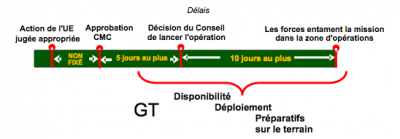Battlegroups, a beautiful tool left fallow

A true rapid reaction force of the European Union, the battlegroups (in English) or tactical groups (in French) were set up in 2007.
Each semester, two battlegroups are on call according to a schedule defined several years in advance by the Member States by mutual agreement (1). They are made up of one or more countries, which freely associate, to form a force of around 2000 soldiers. Third countries can participate (Croatia, Norway or Türkiye). Today there is thus a permanent battlegroup led by Spain (with France and Portugal) and another led by Italy (with Romania and Turkey) (2), they will be relayed in January by the Nordic Battlegroup (led by Sweden) (3) and the Dutch-led "Saxon" battlegroup (with Germany, Finland, Austria, and Lithuania) (4).
A Franco-British idea appropriated by the other Member States
The battlegroups were born from a Franco-British initiative. In March 2004, a reflection document was presented to the Council of Ministers of the 15. The basic concept was then developed by the European Union (EU) General Staff and approved at the Military Committee on June 14, 2004. It will be followed by additional concepts (C2 command and control, logistics transport, medical support, training, reserves, feedback) and synthesized in a single document in October 2006.
The first battlegroup was set up in January 2005 and became operational two years later on January 1, 2007. It has never been used since despite certain needs and opportunities (as in the Congo). But some Member States like the Nordics are determined to use it as soon as possible (5). The concept was moreover relaxed in November 2009 (6). And the Hungarian presidency does not rule out working again on this subject, as its Minister of Defence, Csaba Hende, confided to Brussels2 recently (7).
rapid reaction force
The battlegroup is defined as " the minimum force package to be militarily effective, credible, coherent and capable of autonomous actions or the conduct of the initial phase of a larger operation".
It can be deployed quickly, no later than 15 days after the decision to intervene. But its mission is quite short between 1 month (initial duration) up to 4 months (extension). It can be employed autonomously or as an initial entry force should the crisis require a greater commitment.

A battlegroup is likely to fulfill all EU missions, ie the so-called Petersberg missions (peacekeeping, interposition, security of humanitarian convoys, etc.) as defined by the Lisbon Treaty. Most often, it requires a UN Security Council resolution, but for some operations such a resolution is not necessary (for example for the evacuation of European citizens).
battalion size
The BG1500 or GT1500 for specialists is the size of a battalion of about 1500 soldiers, associated with a headquarters and intrinsic projection means. In all it usually consists of 2 to 2500 people.
- a fighting core (Core BG) consisting of an infantry battalion generally augmented by one or more additional combat units, depending on the mission (armoured, mechanized infantry, etc.),
- a key core which includes at least a command post system (C2), a combat unit and its support (light fire, reconnaissance),
- tactical support (Combat support), employed on the scene of the action,
- tactical and strategic logistics capabilities supporting the mission.
To be considered as an EU Battlegroup, a grouping of forces must meet
precise standards in terms of military capabilities, defined by mutual agreement, undergo a fairly long training and certification process (12 to 24 months in advance).
Read also:
- (1) The EU Battlegroup schedule for 2011 and beyond (updated)
- (2) Turks on duty for the EU from July 1
- (3) Nordic Battlegroup Completes Recruitment
- (4) Troubles on the Belgian border, the "Saxon" battlegroup intervenes
- (5) Sudan, possible field of employment of the Battlegroups. If yes…
- (6) The flexibility of Battle groups: “an extremely limited advance”
- The Battle Group Flexibility Discussion Will Continue
- (7) Csaba Hende, Hungarian Defense Minister, presents his priorities


The battlegroup concept is not flexible enough despite appearances and that is why it is not used. It is too much copied from an army type military model. However, the crises are diverse and do not necessarily require the use of land military forces. What is important to intervene:
– a permanent civil-military crisis planning and management cell; this cell can be a nucleus of about twenty people capable of cold planning, of reacting in the first echelon and of being immediately reinforced by ad hoc modules. This cell must be able to plan and launch the first deployment orders in the military and civilian fields: modes of action and catalog of standard means, means of command, control and communication (C3), logistical means of transport and support. in this case, battlegroups would only be one of the standard means; could also be in the catalog; civil protection forces (fires, natural disasters), air transport command in Eidhoven, maritime projection, support and area control forces, French and British Awacs, C3s labeled within the framework of NATO, etc. ..We see that the implementation of this reaction capacity goes well beyond battle groups while being realistic and not very expensive. Indeed, the catalog of forces is available at the Agency, the planning and conduct skills are available in the countries that have held the NRF (Nato Reaction Forces) on-call duty.